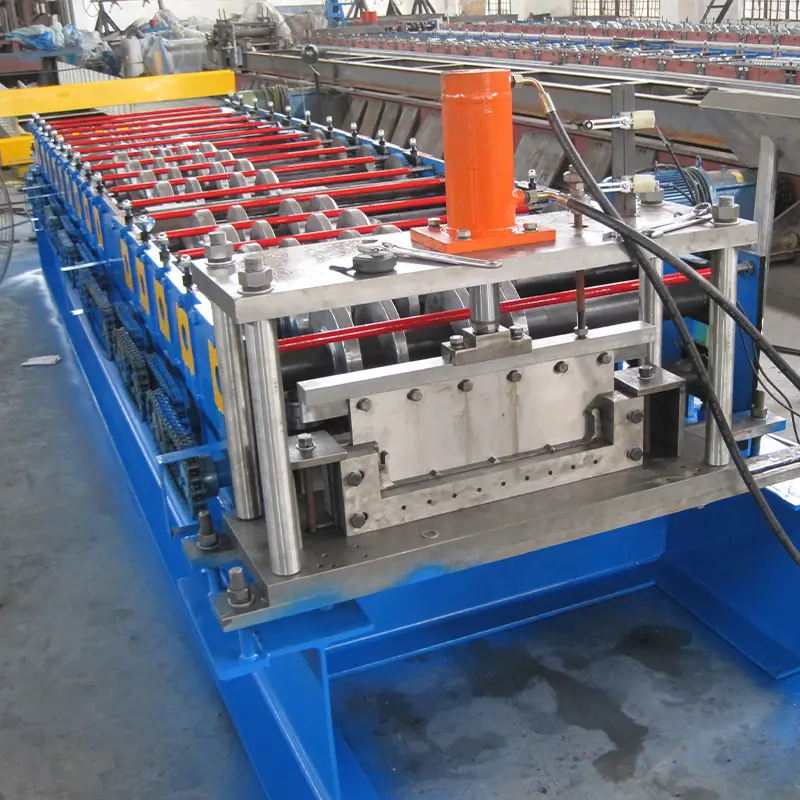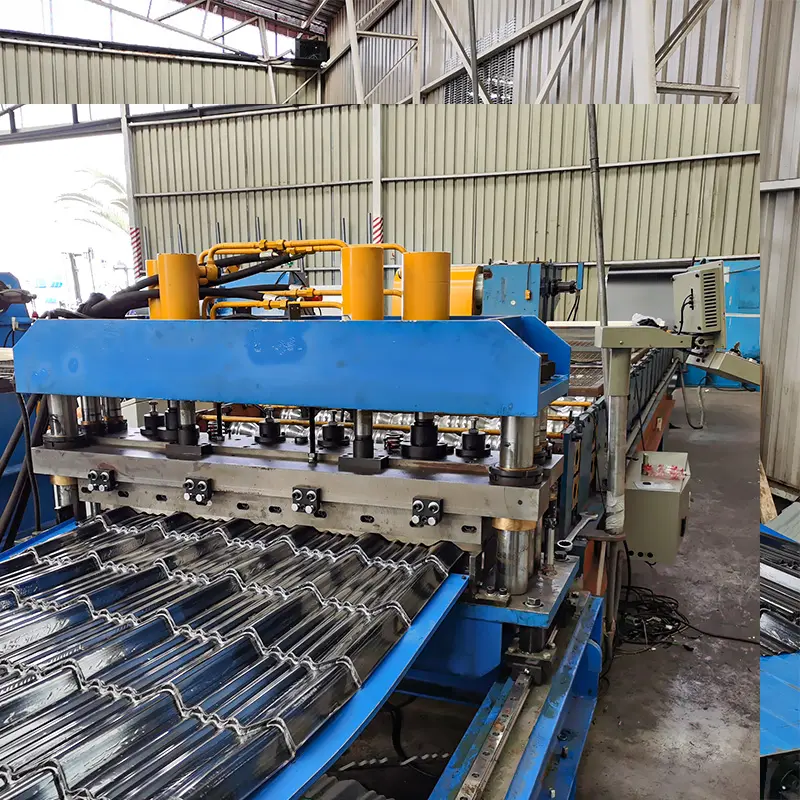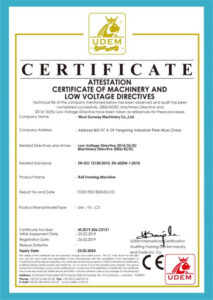Perfiladoras de juntas planas son líneas especializadas diseñadas para formar de forma continua paneles de tejado metálico de junta alzada entrelazados a partir de bobinas de chapa metálica.
Características principales de las perfiladoras de juntas alzadas:
- Fabricar cubiertas metálicas arquitectónicas populares
- Paneles conformados en frío gradualmente a través de matrices progresivas
- Formar costuras que permitan la expansión/contracción
- Evite las penetraciones en el tejado con clips ocultos
- Ideal para bobinas de tejado metálico preacabado
- Producción más rápida frente a las perfiladoras portátiles
- Se utiliza para tejados comerciales, industriales y residenciales
El perfilado de junta alzada ofrece un eficiente perfilado en línea para cubiertas metálicas sin juntas y estancas.
Tipos de perfiladoras de juntas planas
| Tipo de máquina | Descripción |
|---|---|
| Horizontal | La banda pasa horizontalmente por los cabezales de formado |
| Vertical | La banda se alimenta verticalmente para una disposición compacta |
| Pared simple | Formas simples paneles de pared |
| Doble pared | Añade refuerzo a la pared interior |
| Mecánica | Formación de costuras mediante leva |
| Hidráulico | Cilindros hidráulicos de cierre |
Máquinas horizontales proporcionan un encofrado recto para paneles largos. Máquinas verticales ahorrar espacio. Posibilidad de configuraciones de pared simple o doble. Costura mecánica o hidráulica disponible.

Componentes clave de las líneas de rodillos de costura estacionaria
| Componente | Función |
|---|---|
| desbobinador | Introduce la bobina metálica en la línea |
| Nivelador | Aplana la banda para un conformado uniforme |
| Estaciones de mecanizado | Formar gradualmente los perfiles de los paneles |
| Costura | La fase final dobla y frunce las costuras |
| Cizalla/Punzón | Cortar a medida; perforar los agujeros para los clips |
| Apilador | Apila los paneles acabados para facilitar la descarga |
El robusto desenrollador, la nivelación de precisión, el utillaje de ingeniería, el engatillado especializado y el apilador optimizan la producción de paneles de costura en pie.
Aplicaciones típicas de la máquina perfiladora de juntas planas
| Sector | Usos comunes |
|---|---|
| Comercial | Centros de distribución, oficinas, edificios comerciales |
| Institucional | Escuelas, hospitales, iglesias, gobierno |
| Industrial | Almacenes, fábricas |
| Agricultura | Graneros, cobertizos para equipos, edificios de almacenamiento |
| Residencial | Casas a medida, apartamentos |
Cualquier aplicación de cubierta metálica en la que se desee un tejado de junta alzada atractivo y estanco. Popular en muchos sectores.
Normas de diseño para líneas de rodillos de costura en pie
| Componente | Normas |
|---|---|
| Marco | Acero soldado pesado con alivio de tensión |
| Herramientas | Rodillos templados rectificados con precisión |
| Costura | Matrices y guías de engaste endurecidas |
| Unidades | Reductores de engranajes cilíndricos o servomotores |
| Controla | Control PLC con pantalla táctil HMI |
| Seguridad | Protección total, paradas de emergencia, enclavamientos de acceso |
| Códigos | Normas AISI, ASTM, ASME, IBC, OSHA |
Los rigurosos criterios de diseño garantizan la calidad constante del encofrado, el tiempo de producción, el funcionamiento seguro y el rendimiento del techo acabado durante décadas.
Especificaciones de las perfiladoras de juntas planas
| Parámetro | Valores típicos |
|---|---|
| Velocidad de línea | 10 - 40 pies/min |
| Anchura de la hoja | 24 - 48 pulgadas |
| Medidor de material | Calibre 24 - 22 |
| Altura de la costura | 1 - 3 pulgadas |
| Tolerancia de longitud | ± 1/8 pulgada |
| Longitud Capacidad | 8 - 40+ pies |
| Peso de la máquina | 6.000 - 12.000 libras |
Las velocidades, anchuras y longitudes varían según el tamaño y el modelo de la máquina. Los calibres más gruesos son posibles con herramientas especiales.
Precios de las líneas de rollos de paneles de tejado de junta alzada
| Fabricante | Precios |
|---|---|
| Metform | $120,000 – $250,000 |
| Samco | $140,000 – $280,000 |
| Mesco | $100,000 – $220,000 |
| Proveedores de China | $80,000 – $180,000 |
Los costes oscilan entre $80.000 y $280.000 en función de las características. La instalación y el transporte suponen 10-20% más.
Instalación y configuración de máquinas de costura en pie
| Tarea | Descripción |
|---|---|
| Descarga | Utilizar métodos y equipos de elevación adecuados |
| Posicionamiento | Disposición según planos de planta |
| Anclaje | Atornillar la máquina a los cimientos en todos los puntos |
| Nivelación | Ajuste la máquina para obtener un nivel preciso |
| Montaje | Instalar desenrollador, nivelador, apilador, transportadores |
| Conexión | Cableado de los cables principales de alimentación y control |
| Inicialización | Encendido; prueba y ajuste de componentes |
| Prueba de funcionamiento | Corre lentamente comprobando todas las funciones |
Una instalación, alineación y comprobación adecuadas evitan problemas y garantizan una alta calidad de producción.
Funcionamiento y mantenimiento de las líneas de costura en pie
| Actividad | Frecuencia |
|---|---|
| Controles de seguridad | Por turno |
| Ajuste de parámetros | Según sea necesario |
| Lubricación de herramientas | Diario |
| Servicio hidráulico | Trimestral |
| Cambio de rollo | Según sea necesario |
| Lubricación de rodamientos | Mensualmente |
| Aceite de la caja de cambios | Por manual |
| Calibrado de máquinas | Anual |
Deben seguirse los procedimientos de seguridad diarios. Un funcionamiento cuidadoso optimizado con un mantenimiento regular mantiene el rendimiento.
Selección de un fabricante de perfiladoras de juntas planas
| Consideraciones | Orientación |
|---|---|
| Experiencia | Experiencia significativa con líneas de costura en pie |
| personalización | Posibilidad de adaptar la máquina a las necesidades |
| Apoyo | Ayuda para la instalación, formación, disponibilidad de servicios |
| Fiabilidad | Longevidad probada y tiempo de inactividad mínimo |
| Reputación | Marca de confianza conocida por sus equipos de calidad |
| Valor | Precio razonable para las prestaciones ofrecidas |
Se aconseja buscar fabricantes con experiencia especializada en tecnología de perfilado de juntas alzadas.
Ventajas del perfilado de juntas
- Paneles de junta alzada uniformes y de alta calidad
- Producción más rápida frente a las perfiladoras portátiles
- Formado in situ a partir de bobina metálica
- Las fijaciones ocultas evitan las penetraciones en el tejado
- Permite la expansión/contracción de paneles largos
- Cubierta metálica de aspecto arquitectónico y elegante
- Duradero y totalmente estanco
- Resiste la corrosión, el óxido y los elementos
- Reciclable y respetuoso con el medio ambiente
- Menor mano de obra de instalación frente al herpes zóster
El perfilado de junta alzada ofrece enormes ventajas en cuanto a calidad, rapidez, rendimiento y estética de las cubiertas metálicas.
Limitaciones de la tecnología de rodillos de junta alzada
- Coste más elevado que la típica laminadora portátil
- Equipos grandes que requieren espacio interior
- Se necesitan operarios cualificados para
- Importantes necesidades de energía
- Rodillos y utillaje específicos para cada perfil de tejado
- Solución de problemas y mantenimiento especializados
- No es tan portátil como las perfiladoras móviles
- Curva inicial de aprendizaje del funcionamiento
- Generación de chatarra durante el montaje
- Elevación necesaria para la carga de bobinas
Las limitaciones se refieren principalmente a un coste de capital más elevado y a un funcionamiento y mantenimiento especializados.

Comparación de costes: Roll Formed vs Portable Standing Seam
| Método | Costo | Beneficios | Inconvenientes |
|---|---|---|---|
| Perfilado | $100k - $300k | Gran volumen, velocidad y consistencia | Alto coste inicial, mantenimiento |
| Portátil | $25k - $60k | Bajo coste, transportable | Producción más lenta, variabilidad |
El perfilado ofrece una productividad y una calidad superiores, pero requiere una mayor inversión inicial. Las máquinas portátiles son más lentas pero más asequibles y móviles.
Solución de problemas comunes de la laminadora de juntas estacionarias
| Edición | Solución |
|---|---|
| Costuras inconsistentes | Ajuste/sustitución de matrices de engaste desgastadas |
| Marcado de bandas | Aumentar la dureza del rodillo; ajustar las guías |
| Atasco de hojas | Comprobar la holgura del nivelador; alisar los perfiles de las herramientas |
| Fugas hidráulicas | Sustituir juntas, mangueras, cilindros |
| Exceso de vibraciones | Inspeccionar/apretar las fijaciones; comprobar la alineación |
| Fallos eléctricos | Comprobación/sustitución de cables, accionamientos, conexiones |
Mantener las matrices de prensado en perfecto estado y repararlas rápidamente evita tiempos de inactividad imprevistos. El mantenimiento adecuado de la alimentación y las herramientas también es fundamental.
Preguntas más frecuentes
P: ¿Qué capacidades de calibre de chapa son habituales?
R: La mayoría de las máquinas admiten material de 24 a 22 galgas. Es posible utilizar calibres más gruesos con herramientas especiales.
P: ¿Qué alturas de costura se pueden formar?
R: Las alturas habituales oscilan entre 1 y 3 pulgadas. Son posibles perfiles personalizados.
P: ¿Cuánto se tarda en cambiar a un nuevo perfil de tejado?
R: Con troqueles y utillaje de cambio rápido, el cambio se realiza en 1-2 horas.
P: ¿Qué factores afectan a la duración del ciclo y a la cadencia de producción?
R: El calibre de la chapa, la potencia de la máquina, la complejidad de la pieza y la longitud influyen en la velocidad de producción.
P: ¿Cuáles son los requisitos de potencia de las líneas de juntas alzadas?
R: La potencia oscila entre 30 kW en las unidades más pequeñas y más de 100 kW en las líneas de gran capacidad.
P: ¿Qué grosor de paneles de tejado pueden fabricar las máquinas de junta alzada?
R: Las bobinas de acero de calibre 24, 22 y algunas de calibre 20 pueden formarse con una anchura de hasta 48 pulgadas.
P: ¿Qué dispositivos de seguridad incorpora?
R: Protección total, paradas de emergencia, enclavamientos y fiabilidad de control según las normas vigentes.
P: ¿Cuál es la vida útil prevista de una perfiladora de juntas alzadas?
R: Con un mantenimiento adecuado, la vida productiva suele ser de entre 15 y 20 años.


